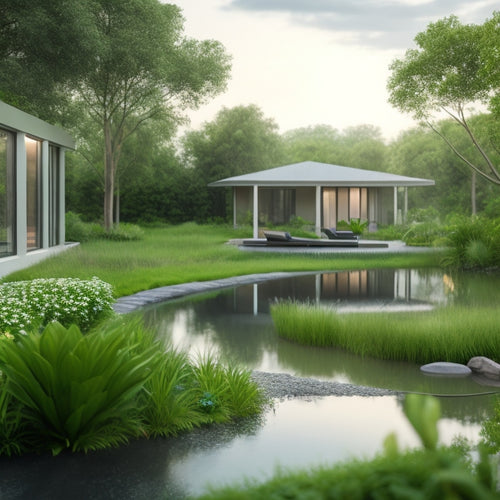
3 Tips: Navigating Home Wind Turbine Rules
Share
When maneuvering home wind turbine rules, you'll want to start by understanding local zoning laws, including placement and installation regulations, setback requirements, and property easements. Next, assess turbine noise restrictions, considering decibel levels and their impact on neighborhood disturbance. Finally, verify your turbine meets electrical grid requirements, aligning output with grid voltage and frequency standards, and obtaining an interconnection agreement from your utility company. By tackling these key areas, you'll be well on your way to a successful installation - and there's more to investigate to guarantee a seamless process.
Key Takeaways
- Research local zoning laws and ordinances to ensure compliance with setback requirements and property easements.
- Understand turbine noise restrictions to minimize neighborhood disturbance and ensure compliance with dB levels.
- Confirm the turbine's electrical output aligns with grid voltage and frequency standards to avoid infrastructure upgrades.
- Obtain an interconnection agreement from the utility company to ensure safe and compliant grid connection.
- Ensure UL certification and protective relaying to adhere to safety standards for home wind turbines.
Understanding Local Zoning Laws
Before installing a home wind turbine, it's vital to understand the local zoning laws that govern your property. These laws dictate the placement and installation of your turbine, guaranteeing it doesn't infringe on neighboring properties or compromise local aesthetic standards.
Setback requirements, for instance, specify the minimum distance your turbine must be from property lines, roads, and habitable structures. You'll also need to take into account property easements, which grant access to your land for utility companies or other entities.
Additionally, it's important to be aware of federal tax credits available for eco-friendly initiatives, such as the new clean vehicle credit, which can incentivize sustainable energy adoption.
Failure to comply with these regulations can result in costly fines or even turbine removal. Research your local ordinances to guarantee a smooth and successful installation process that respects your freedom to generate clean energy.
Assessing Turbine Noise Restrictions
As you maneuver local zoning laws, you'll also need to contemplate another key aspect of home wind turbine installation: noise restrictions. Turbine noise can have a significant impact on your neighborhood, so it's crucial to assess the potential disturbance.
| Turbine Decibel Levels | Distance from Turbine | Neighborhood Impact |
|---|---|---|
| 40 dB | 100 ft | Conversational speech, minimal disturbance |
| 50 dB | 200 ft | Background noise, moderate disturbance |
| 60 dB | 400 ft | Vacuum cleaner, significant disturbance |
| 70 dB | 800 ft | Lawn mower, extreme disturbance |
Consider the turbine's decibel levels and how they'll affect your neighbors. Make sure you comply with local noise ordinances to avoid potential disputes.
Meeting Electrical Grid Requirements
Most residential electrical grids can accommodate a single home wind turbine, but it's vital that you confirm your system meets the grid's requirements to avoid any disruptions or safety hazards.
You'll need to verify your turbine's electrical output matches the grid's voltage and frequency standards. In addition, considering the complexity of electrical infrastructure upgrades electrical capacity assessments is important to determine the required electrical capacity.
Moreover, identifying potential electrical bottlenecks is necessary for planning. Obtain an interconnection agreement from your utility company, which outlines the terms for connecting your turbine to the grid.
This agreement will specify safety standards, such as protective relaying and grounding requirements, that you must adhere to. In addition, your turbine must comply with relevant safety standards, like UL (Underwriters Laboratories) certification.
Frequently Asked Questions
Can I Install a Home Wind Turbine in a Residential Area?
Imagine sailing smoothly, then hitting choppy waters - that's what installing a home wind turbine in a residential area can be like. You'll need to maneuver through zoning regulations, noise concerns, and aesthetic impact to secure installation permits, meeting local ordinances and maintenance requirements.
Do I Need to Notify My Neighbors About Turbine Installation?
You'll likely need to notify your neighbors about turbine installation, as they may be concerned about potential turbine noise impacts; being upfront can help maintain positive neighbor relationships and avoid potential disputes down the line.
Will a Wind Turbine Increase My Property Value?
You'll likely see a property value increase, as a wind turbine can enhance your property appraisal, thanks to the long-term energy savings and eco-friendly appeal, which attracts buyers who value freedom from reliance on public utilities.
Can I Install a Turbine on Rented or Leased Property?
You'll need to review your renter agreements carefully, as installation permissions vary; make certain you have explicit consent from your landlord before installing a turbine, and be prepared to provide documentation to support your request.
Are There Any Tax Incentives for Home Wind Turbine Owners?
You're steering the financial terrain of home wind turbines like a sailor charting uncharted waters, and tax incentives are your North Star; you're eligible for tax credits covering up to 30% of installation costs, greatly reducing your upfront investment.
Related Posts
-

3 Best Solar-Powered Biodegradable Accessories for Your Home
You're taking a significant step towards a more sustainable lifestyle by incorporating solar-powered biodegradable ac...
-

7 Best Home Hydrogen Fuel Cells for Clean Power
You're considering adopting hydrogen fuel cells for clean power at home, but you want to know the best options. Reput...
-

7 Best Automated Sprinklers for Water-Wise Green Homes
You're likely among the 75% of U.S. homeowners who use in-ground sprinkler systems, and coincidentally, you're also c...


